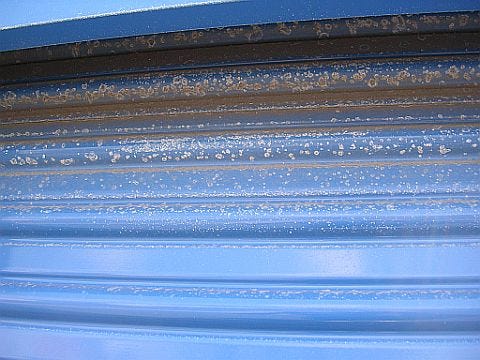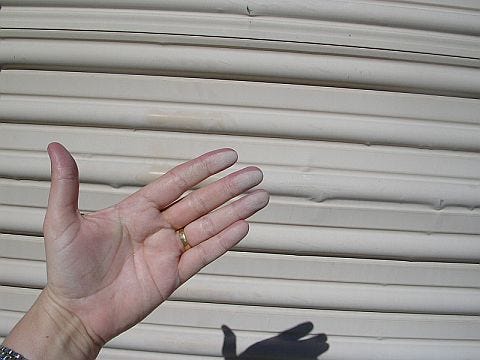Unit doors are a predominant component of every self-storage property. They not only contribute to curb appeal, they play an important role in site security and the overall customer experience. So, it’s critical that they be well-maintained. The following six tips will help you keep them clean and well-functioning as well as extend their life.

When people see a row of roll-up doors on a building, most immediately think “self-storage.” The unit doors are generally the most identifiable feature of any industry facility. In this way, they contribute to curb appeal, which is key for attracting new tenants; but they’re also an important part of site security and the overall customer experience.
So, it’s critical that they be well-maintained. The following tips will help you keep this critical component looking great and working properly. This also means your doors will be safer and have a longer life.
Tip 1: Inspect Your Doors Regularly
One of the easiest and yet most crucial maintenance tasks is to inspect your self-storage doors regularly. Performing quarterly or semi-annual assessments will allow you to prevent or detect problems early and minimize expensive repairs. Look for fading or aging paint, acid-rain damage, or salt corrosion. Once these troubles begin, deterioration will accelerate rapidly and be more costly to fix.
An easy way to test the color and gloss of your doors is to wipe an area with a wet cloth or sponge. If there’s a noticeable difference in the appearance, consider applying a high-quality clearcoat. Just remember: It’s important to use a coating that has good adhesion to metal and will expand and contract, as roll-up doors flex when they’re moved up and down.
Acid rain can wreak havoc on your doors, even if you aren’t in an area with refineries, factories or power plants. It permanently etches vertical, dark streaks onto the metal. This damage can’t be reversed, but it can be prevented by applying a high-quality clear coat. Look for one that has built-in corrosion inhibitors. Regular paint breathes, so it doesn’t protect the metal from this this type of damage. This is why a topcoat is important, even on newly painted doors.

Acid-rain damage
For self-storage properties near a coast, salt-air corrosion can be an issue, even if you’re miles from the water. It causes the doors to be rough and bumpy, eventually rusting and blistering, which isn’t fixable. Run your hand over the top ribs, especially on doors on the north side where the salt takes longer to dry. If you feel corrosion starting, use a quality clear coating with salt-resistant properties to prevent further damage.
Tip 2: Remove Chalk
Customers don’t appreciate chalky doors, as the chalk gets on their hands and clothes; plus, it looks terrible. If your doors have this residue, you need to remove it. Thankfully, it’s a simple process.
A typical 8-by-8-foot door can be completely deoxidized in less than 15 minutes. All that’s required is a bucket of plain water and a microfiber towel. Wet the cloth and wring it out, then fold it into a pad. Start at the top and wipe across each rib. Continuously refold the cloth to have a clean surface and rinse often in the water. Most of the chalk will wipe off easily.

Door chalking
Tip 3: Keep Them Clean
Removing dirt and grime from your self-storage doors will extend the life of the paint. Washing with a mild soap and water is great, but even rinsing off the dust occasionally will help. Invest in some microfiber cloths or soft-bristled brushes that fit on poles.
Tenants tend to keep boxes piled right up to the door, so be careful to not get water into the unit. This can happen if a stream is aimed above the door or directly into the edges. Using pressure-washers isn’t recommended.
If you have hard water, don’t rinse your doors in direct sunlight or you may get water spots. Opt for the shade instead. An inexpensive filter attached to your hose can help. These are available at RV-supply or camping stores.
Obviously, interior doors can’t be washed with a hose because the water will run under the walls. Even buckets of water are a risk, as they can easily be tipped. For fingerprints or smudges, use a spray cleaner and a cloth. A good alternative is a quality, waterless wash-and-wax.
When a unit is vacant, wipe the door guides, as dirt and cobwebs can block the mechanisms; and doors that are hard to open and close frustrate customers and can be dangerous. Just don’t use grease or WD-40, as it’ll attract dirt and further gum up the rollers.
Tip 4: Adjust Door Springs
An all-too-common problem with self-storage doors is the felt between the layers sags over time, causing dark streaks down the front of the door. This means a spring adjustment is necessary. The marks can be cleaned with a #000 synthetic steel-wool pad, which will remove them without damaging the paint.
It’s best to refer to your door manufacturer’s installation instructions for specific tension-adjustment procedures. Most operators choose to hire a trained rolling-door technician to handle this task.
Tip 5: Remove Graffiti
Graffiti should be removed as soon as possible. If spray paint was used (i.e., tagging), it’ll continue to cure and become more difficult to eliminate. Check the colorfastness of your door paint, then use a mild graffiti remover. Hopefully, addressing this quickly will discourage future incidents.
Tip 6: Avoid Unsafe Products
Make sure the cleaning products you use on your self-storage doors are designed for this purpose. Silicone-based products like Pledge can leave a film that attracts dirt and debris, making maintenance much more difficult down the road. Vinegar can help prevent water spots, but it’ll etch bare metal and can cause rust on hasps. TSP (trisodium phosphate) may clean well but will also etch doors, causing additional oxidation and damage.
Also, make sure that any coatings or paints you use are specified for exterior roll-up doors. They should offer protection from harmful UV rays, salt corrosion, rust and other damaging elements.
Unit doors are a big part of your self-storage brand and curb appeal, which is the way your property is remembered by customers and visitors. If you take care of them, they’ll last longer, look better and need less maintenance down the road.
Jackie Belau is a controller with Everbrite Inc. She helps the company expand into new industries and build brand awareness. To reach her, call 916.995.6398 or email [email protected].
About the Author(s)
You May Also Like





